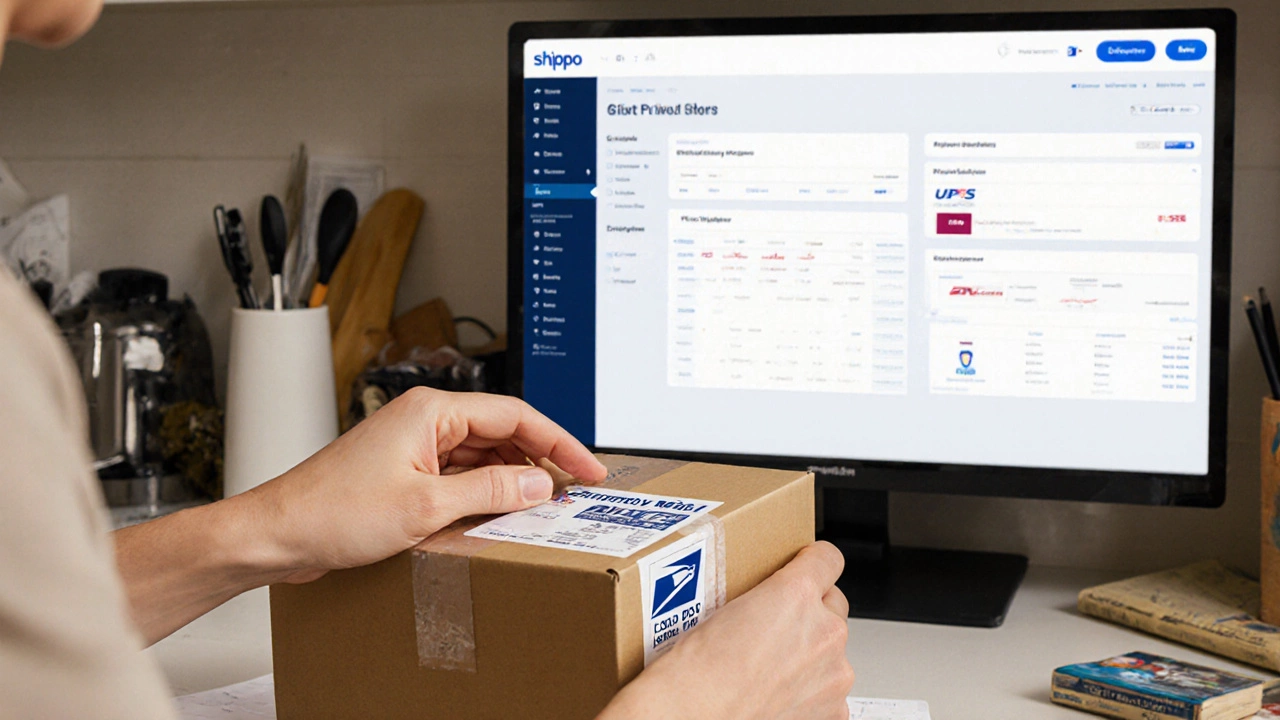USPS vs. Logistics Provider Decision Tool
Is USPS Right for Your Business?
Answer these questions to find out if you need a logistics provider or if USPS is sufficient for your shipping needs.
People often ask: Is USPS a logistics company? The answer isn’t yes or no-it’s more like "it depends on what you mean by logistics." If you think logistics means moving packages from point A to point B, then yes, USPS does that every single day. But if you’re thinking of a modern logistics firm with real-time tracking, warehouse automation, or custom supply chain solutions, then USPS doesn’t fit that mold. It’s not wrong to call it logistics-it’s just incomplete.
What USPS Actually Does
USPS, or the United States Postal Service, delivers about 47% of the world’s mail volume. That’s more than 18 billion pieces of mail each year. Most of it? Letters, bills, and catalogs. But in the last decade, packages have taken over. In 2024, USPS handled over 10 billion packages-more than FedEx and UPS combined during peak holiday seasons.
They don’t just deliver to city centers. They go to every address in the U.S., no matter how remote. A mailbox in rural Montana, a cabin in Alaska, a trailer park in Mississippi-USPS shows up. That’s called universal service obligation. No other carrier in the world is legally required to do that.
They’ve built a delivery network that includes 32,000 post offices, 250,000 mail carriers, and 200 million delivery points. That’s not a startup with a few vans and an app. That’s infrastructure built over 248 years.
Why People Confuse USPS With Logistics Companies
Logistics companies like FedEx, DHL, and Amazon Logistics don’t just move boxes. They manage inventory, optimize routes with AI, offer same-day pickup, integrate with Shopify and WooCommerce, and provide customs clearance for international shipments. They sell services. They have sales teams. They negotiate contracts.
USPS doesn’t do any of that. You can’t call them to negotiate a discount on 5,000 shipments. You can’t ask them to hold your packages at a fulfillment center. You can’t get a custom API to sync your e-commerce platform with their system.
But here’s the twist: when you buy something on Amazon and it arrives in a small brown box with a USPS label, you’re using their network. When you ship a gift to your cousin in Ohio using Priority Mail, you’re relying on their infrastructure. So even though USPS doesn’t act like a logistics company, millions of businesses and consumers use them as if they are.
The Real Difference: Infrastructure vs. Service
Think of it this way: FedEx is a restaurant. You order a meal, they customize it, deliver it hot, and send you a survey. USPS is the highway system. You drive your own car, pack your own lunch, and still get to your destination.
USPS owns the roads. They don’t build the cars. They don’t design the GPS. They don’t choose where you’re going. But without them, nothing moves.
That’s why e-commerce sellers use USPS as a last-mile partner. They handle the final delivery-often cheaper and more reliable than private carriers in rural areas. But they still need third-party tools like Shippo, Pirate Ship, or Easyship to print labels, track packages, and manage returns.

Who Uses USPS for Logistics? (And Why)
Small businesses, home sellers, nonprofits, and hobbyists rely on USPS because it’s affordable. A First-Class Package Service shipment under 1 pound costs $4.25. Compare that to FedEx Ground, which starts at $9.10 for the same weight and distance.
Amazon uses USPS for its Amazon Shipping program in areas where it’s more cost-effective. Walmart partners with USPS for rural deliveries. Even large brands like Nike and Target use USPS for low-value, high-volume shipments.
Why? Because USPS has something no private carrier can match: reach. If you’re shipping to a ZIP code with fewer than 500 people, USPS is often the only option. And they do it for less.
What USPS Can’t Do (And Why It Matters)
Here’s where the gap shows:
- No real-time tracking updates beyond scan points
- No scheduled delivery windows
- No package holding or pickup scheduling
- No customs brokerage for international shipments
- No API access for automated order fulfillment
- No returns management system
If you run a Shopify store with 100 orders a day, you can’t manage returns, inventory sync, or international taxes with USPS alone. You need a logistics platform. USPS is just one leg of the journey.
Compare that to a true logistics company like ShipBob or Deliverr. They warehouse your inventory, pack orders, print labels, and handle returns-all under one roof. They’re full-stack. USPS is just delivery.
So Is USPS a Logistics Company? The Verdict
Technically? No. USPS is a government-run postal service. Their mission isn’t profit or efficiency-it’s universal access. They’re not trying to compete with FedEx. They’re trying to make sure your grandmother gets her Social Security check.
Practically? Yes. Millions of businesses treat USPS as a logistics partner because it’s the most reliable, affordable way to get packages to doorsteps across the country.
The real question isn’t whether USPS is a logistics company. It’s whether you need a logistics company-or just a delivery network.
If you’re shipping one box a week? USPS works fine.
If you’re scaling an e-commerce brand? You’ll need more than a post office.

What to Use Instead (When You Need More)
Here are your options if USPS isn’t enough:
- For small businesses: Use Shippo or Pirate Ship to get discounted USPS rates + better tracking
- For medium-sized e-commerce: Try ShipBob or Easyship for warehousing + multi-carrier shipping
- For international: DHL Express or FedEx International Economy for customs handling
- For same-day: Uber Connect or Postmates (in supported cities)
USPS is a tool. Not a solution.
How to Decide: USPS or a Logistics Provider?
Ask yourself these questions:
- Do I ship more than 50 packages a month?
- Do I need returns, tracking, or customs support?
- Am I selling online and need to integrate with Shopify, Etsy, or Amazon?
- Do I care about delivery windows or customer notifications?
- Am I shipping outside the U.S.?
If you answered yes to two or more, you’re better off with a logistics provider. If you answered no to all, USPS is still your best friend.
What’s Changing in 2025?
USPS is trying to catch up. They’ve rolled out new tracking features with real-time alerts. They’ve started partnering with private companies to offer same-day delivery in 10 major metro areas. They’re testing automated sorting centers.
But they’re still bound by law, budget, and legacy systems. They can’t move fast. They won’t compete on features. They’ll keep doing what they’ve always done: delivering to every door, every day, no matter what.
That’s not logistics. That’s public service.
Is USPS considered a courier service?
USPS is not a courier service in the traditional sense. Courier services like FedEx, UPS, and DHL offer premium, time-sensitive delivery with tracking, customer support, and flexible options. USPS delivers mail and packages as part of its universal service obligation, but it doesn’t provide the same level of service customization, speed guarantees, or business tools that couriers do.
Does USPS offer logistics solutions for businesses?
USPS doesn’t offer logistics solutions like warehousing, inventory management, or supply chain optimization. They provide shipping and delivery services only. Businesses that need end-to-end logistics use third-party platforms like ShipBob, Shippo, or Easyship to combine USPS with other carriers and tools.
Can I use USPS for international shipping?
Yes, USPS offers international shipping through services like Priority Mail International and First-Class Package International Service. But they don’t handle customs clearance, duties, or taxes for you. You’re responsible for filling out forms and paying fees. For complex international shipping, companies like DHL or FedEx are better suited.
Why do big companies like Amazon use USPS?
Amazon uses USPS for last-mile delivery in areas where it’s cheaper and more efficient than their own fleet. USPS covers rural and low-density zones where Amazon’s delivery vans would be cost-prohibitive. It’s a partnership of convenience, not capability.
Does USPS have a tracking API for developers?
No, USPS does not offer a public API for real-time tracking or automated label printing. Developers must use third-party platforms like Shippo, Easyship, or Stamps.com to integrate USPS tracking into apps or e-commerce systems. USPS provides basic tracking via their website, but no programmatic access.




